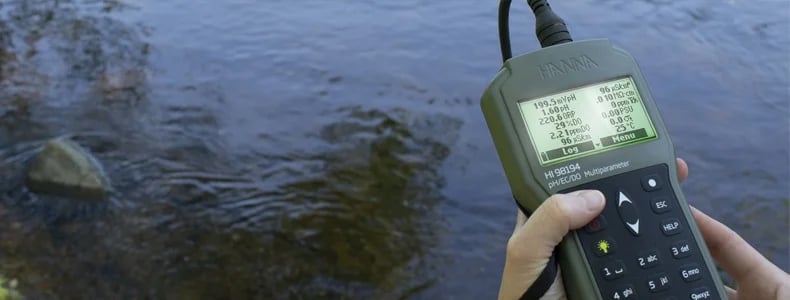Syllabus Edition
First teaching 2015
Last exams 2025
Measuring Water Quality (DP IB Environmental Systems & Societies (ESS)): Revision Note
Measuring Water Quality
To directly test the quality of aquatic ecosystems, various parameters can be measured and analysed.

Water testing is conveniently carried out in the field using digital probes
Some of the different water quality parameters that can be used are:
1. pH
pH measures the acidity or alkalinity of water
pH impacts the survival, growth, and reproduction of aquatic organisms
Unusual pH levels can indicate pollution, acidification, or other environmental changes
2. Temperature
Temperature measures the degree of heat or coldness of water
Temperature affects the metabolic rates, behaviour, and distribution of aquatic organisms
Abnormal temperature fluctuations can stress or harm aquatic life
3. Dissolved Oxygen (DO)
Dissolved oxygen measures the amount of oxygen dissolved in water
Adequate oxygen levels are crucial for the survival of aquatic organisms
Low dissolved oxygen can lead to hypoxia, suffocating or killing aquatic life
4. Suspended Solids (Turbidity)
Turbidity refers to the level of suspended solids, such as sediment, organic matter, or algae, in water
High turbidity reduces water clarity, light penetration, and can disrupt aquatic habitats
Turbidity measurements provide insights into sedimentation, erosion, and overall water quality
5. Metals
Testing for metals, such as mercury, lead, cadmium, or arsenic, assesses contamination levels
Metals can accumulate in aquatic organisms, posing risks to their health and ecosystem integrity
Monitoring metal concentrations helps identify pollution sources and evaluate potential ecological impacts
6. Nitrates and Phosphates
Measuring nitrates and phosphates assesses nutrient pollution in water
High nutrient levels can lead to eutrophication, harmful algal blooms, and oxygen depletion
Monitoring nutrient concentrations helps manage nutrient inputs and prevent water quality degradation
These parameters provide valuable information about the health and condition of aquatic ecosystems
Most of these parameters can be measured using standard water testing kits
The measurements obtained using these kits can be compared to standardised charts, colour charts, or tables that feature known samples
For example, when analysing water for nitrates, uncontaminated water typically contains less than 5 mg dm−3, whilst polluted water may contain 5–15 mg dm−3
It is crucial to compare readings from various locations, such as upstream and downstream of a sewage outlet or factory, to assess any potential impacts on the ecosystem

Photo by Tarek Badr (opens in a new tab) on Unsplash (opens in a new tab)
Measuring water pollution parameters near factory outlets is vital to assessing the impact on ecosystems
Monitoring and analysing these parameters at regular intervals help scientists, environmental agencies, and policymakers understand the overall water quality, identify potential issues, and implement appropriate management strategies to protect and restore aquatic ecosystems

Unlock more, it's free!
Did this page help you?